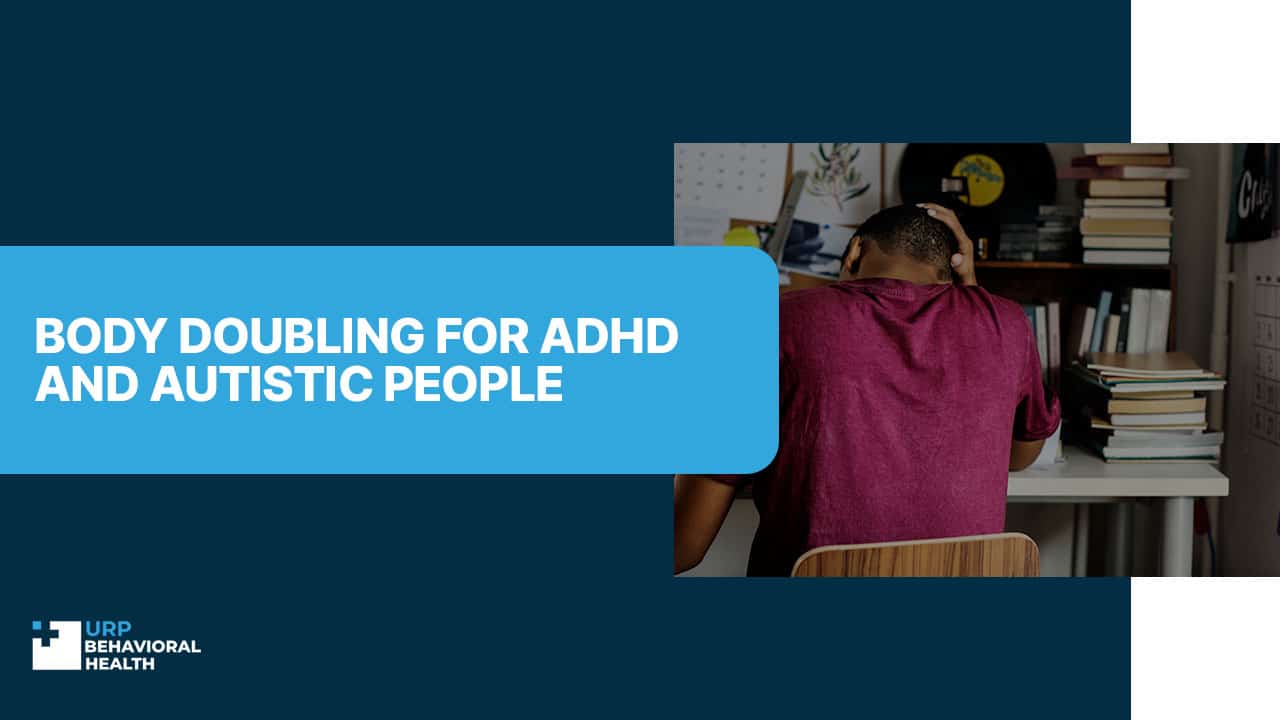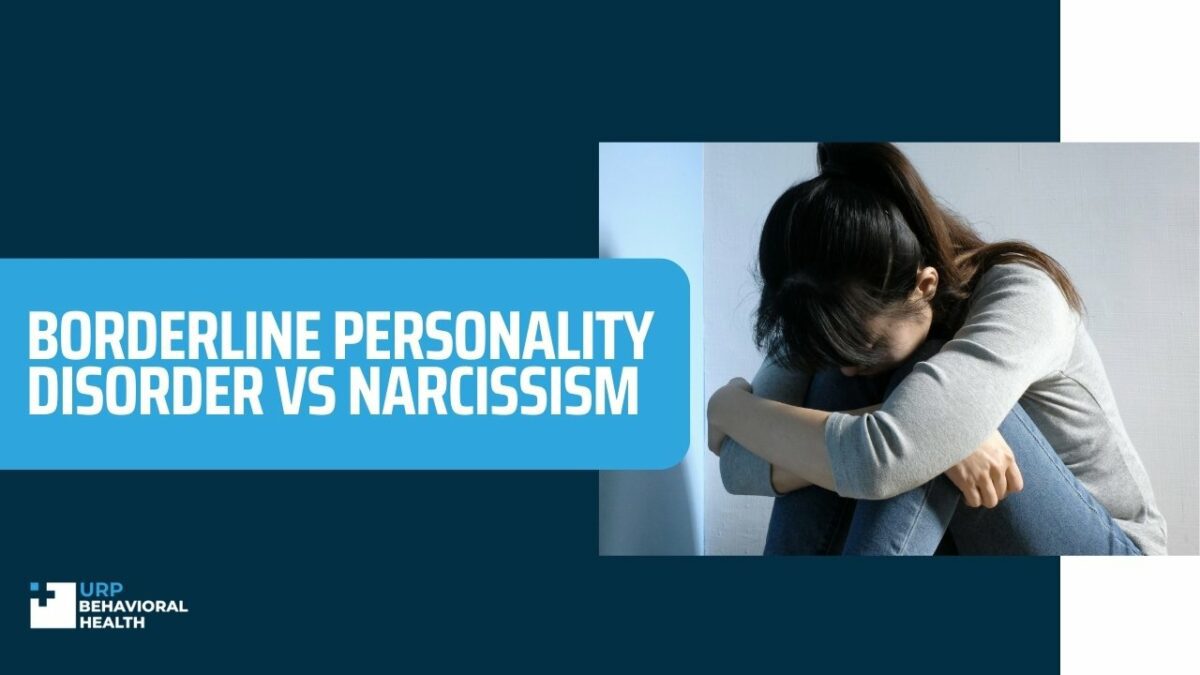
Borderline Personality Disorder vs Narcissism: Differences, Similarities, and Co-Occurrence
Based on statistics by the American Psychiatric Association, around 9 percent of US adults [1] have at least one personality disorder. Among the different personality disorders, BPD is the most common, with a prevalence rate of about 1.4 percent [2]. In contrast, narcissistic personality disorder is less common, but that doesn’t prevent confusion between the two.
Although the two disorders may appear similar because of certain symptoms, they are two distinct conditions. To gain a better understanding, let’s compare them side-by-side to understand their differences, similarities, and the possibility of comorbidity.
What is Borderline Personality Disorder?
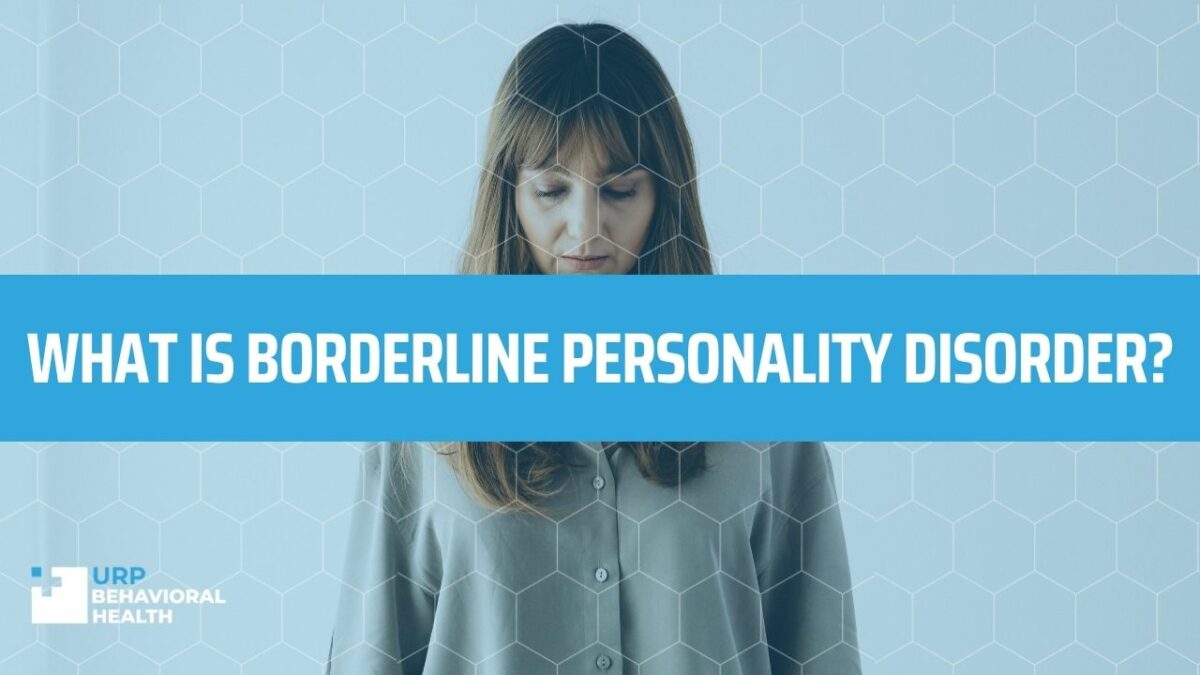
The fifth edition of the APA’s Diagnostic Statistical Manual of Mental Disorders defines BPD as a pattern of instability in your emotions, self-image, and interpersonal relationships, along with feelings of impulsivity.
Symptoms of BPD
The symptoms of borderline personality disorder include:
- Unstable interpersonal relationships: You have intense relationships that alternate between extremes of idealizing and devaluing the other person.
- Fear or abandonment: You engage in frantic efforts to avoid abandonment
- Identity disturbance: You have an unstable sense of self
- Impulsivity: You engage in potentially self-damaging impulsive behaviors
- Emotional dysregulation: You struggle with controlling anger
- Suicidal behavior: You engage in self-mutilating behavior or make suicidal threats
People who experience more symptoms may require constant monitoring. In these cases, an inpatient treatment program at a facility like URP Behavioral Health can be effective for recovery.
What is Narcissistic Personality Disorder
According to the DSM-5, this personality disorder is defined by a need for admiration, an inability to empathize with others, and feelings of grandiosity. The symptoms include:
- Grandiose sense of self-importance: You exaggerate achievements and expect recognition
- Preoccupation with fantasies of power, beauty, success, and brilliance.
- Believing that you’re unique and special, so you can only associate with high-status people
- Sense of entitlement: You have unreasonable expectations of receiving favorable treatment
- Need for admiration: You require excessive admiration in everything you do
- Exploitative: taking advantage of other people to achieve your own gains
- Lack of empathy: inability to recognize how your behaviors affect others
Other symptoms include believing that others are envious of you and having an arrogant attitude.
Reach out today and let us create a treatment plan designed around your needs.

Similarities Between BPD and Narcissism
Both narcissism and BPD can result in unhealthy thoughts and behavioral patterns. People with either BPD or narcissism strongly desire validation and positive attention from other people. And when they fail to receive their desired validation, they may react poorly. Such behaviors can result in volatile relationships.
When you have BPD or narcissistic personality disorder, you may see the world in black and white. And when you make mistakes, you may try to blame it on others. In both conditions, you may become sensitive to negative feedback and criticism. This can lead you to projecting your faults onto others. Additionally, people with either of these personality disorders can develop substance abuse problems.
Differences Between BPD and Narcissism
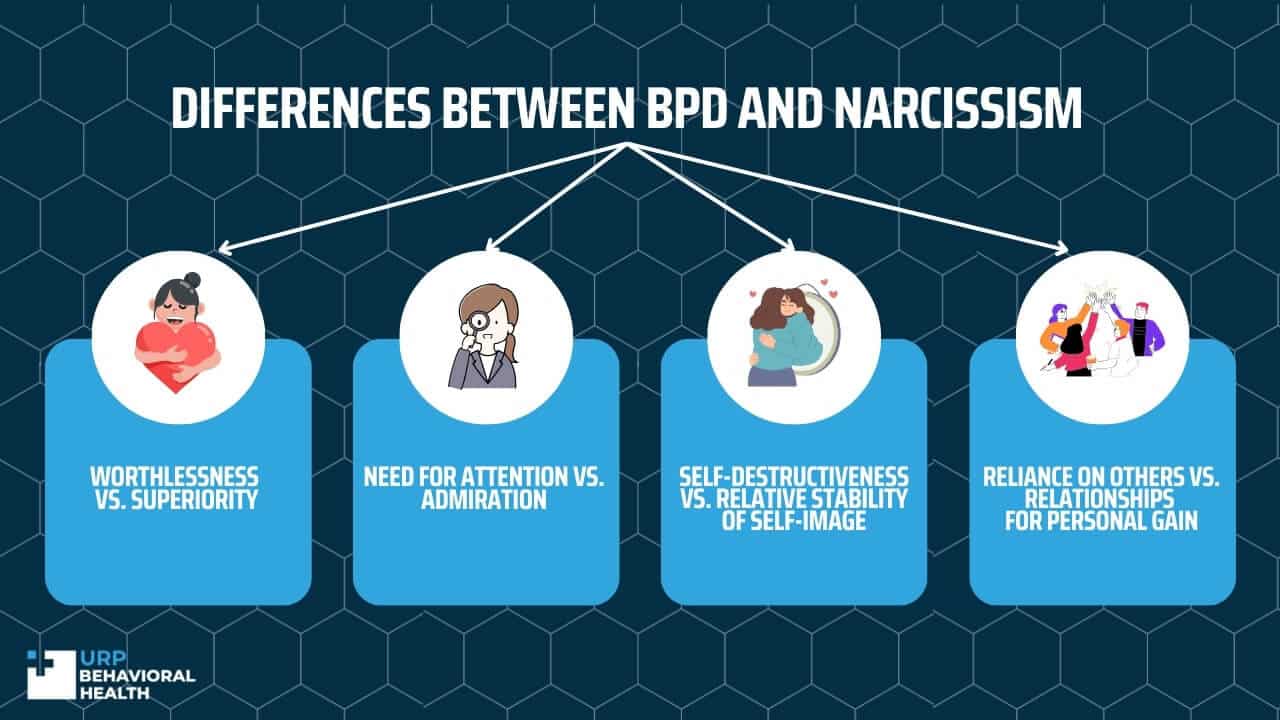
Among the class of different personality disorders, both borderline and narcissistic personality disorders are characterized by a distorted view of reality. That being said, they vary in many ways. The main feature of each condition is different since BPD is characterized by consistent feelings of emptiness and a fear of abandonment. Meanwhile, narcissists have a lack of empathy that prevents them from understanding other people and building emotional connections.
Worthlessness vs. Superiority
One major difference is that people with BPD have an unstable sense of self, leading to feelings of worthlessness and inadequacy. But when you have narcissistic personality disorder, you appear well-adjusted because of strong feelings of superiority.
Need for Attention vs. Admiration
Though people with BPD and NPD need a lot of attention, narcissists need attention in the form of admiration. In BPD, you become emotionally volatile or become emotionally manipulative when your need for attention is not fulfilled. But when you develop NPD, you become manipulative or play the victim when your narcissistic supply is threatened.
Self-Destructiveness vs. Relative Stability of Self-image
Another difference stems from how narcissists believe that they are important people. Because of this, they’re able to maintain a seemingly stable identity and higher level of functionality [3]. In contrast, someone with BPD may have an unstable sense of self that may affect their performance in occupational settings. Not to mention, people with BPD have a tendency to engage in self-destructive behavior. Because of narcissists’ egotistical view of themselves, they’re less likely to be impulsive and self-destructive.
Reliance on Others vs. Relationships for Personal Gain
Borderline personality disorder can result in an unstable sense of self-worth. Because of this, you’ll start relying on other people for your emotional needs. In contrast, someone with NPD may only build relationships as a way to access better opportunities or for their self-gain. And because of their lack of empathy, they fail to understand how their actions affect others.
It’s important to consider these differences when faced with a presentation of a condition that appears similar to both BPD and narcissism. Looking for these differences can help practitioners determine the diagnosis and formulate a treatment plan accordingly.
Can BPD and Narcissism Co-Occur?
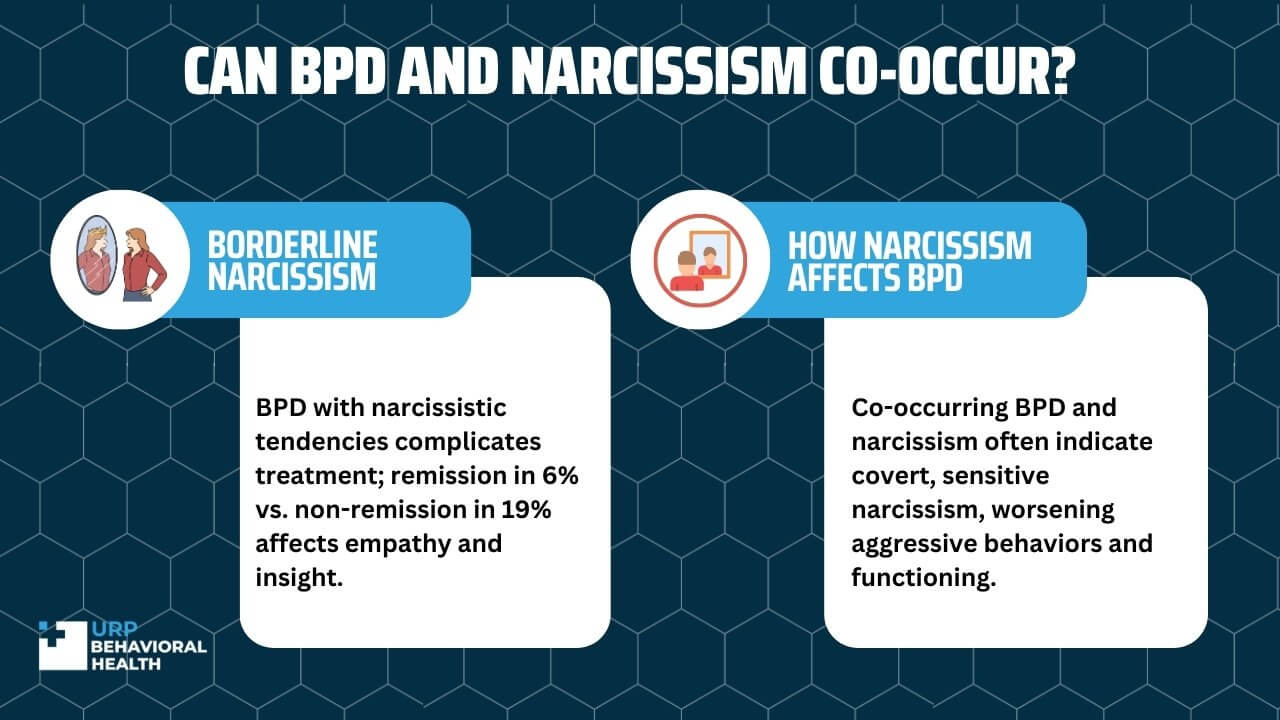
Despite having distinct symptoms, studies indicate a strong rate of comorbidity between BPD and narcissism. In one study, researchers determined that about 13 percent [4] of people with BPD also met the criteria for narcissistic personality disorder. One other report shows that about 39 percent [5] of people with borderline personality disorder may have narcissistic personality disorder, too.
Borderline Narcissism
When you develop co-occurring BPD and narcissism, it’s likely that you have a certain subtype of narcissistic personality disorder called covert narcissism [6]. Also known as vulnerable narcissism, this type is sensitive to criticism and feels distrustful of others.
A borderline narcissist experiences symptoms of BPD and NPD. This includes an unstable sense of self, sensitivity to criticism, insecurity, and covert feelings of grandiosity. When you experience narcissistic tendencies alongside BPD, it worsens your aggressive behaviors and results in poorer functioning [7].
How Narcissism Affects BPD
Developing narcissistic tendencies alongside BPD can make your condition more difficult to treat. Researchers found that clients whose BPD remitted had lower rates of co-occurring NPD at about 6 percent. However, clients whose BPD didn’t remit after six years of diagnosis had higher rates of co-occurring narcissism [8] at about 19 percent.
Because of their lack of empathy, people with NPD don’t understand how their actions affect others. As a result, they have poor insight and are resistant to treatment. Experiencing the two disorders together reduces the likelihood of BPD symptoms improving over time.
Can BPD and Narcissism be Treated?
Personality disorders can be difficult to treat, but when you show a willingness to recover, it can improve outcomes. There are no evidence-based treatments or published clinical trials on the efficacy of treatments for narcissism [9] (either on its own or co-occurring with BPD). Because of the disorder’s variable presentations and lack of scientific investigation, there are no established methods of treatment. That being said, many clinicians recommend adapting BPD-focused therapies to treat NPD.
Our team will verify your insurance and design a plan tailored to your needs.

Of course, it’s important to keep in mind that few narcissists are willing to seek help or change their behaviors. Since their actions are more likely to hurt others, they have a low motivation to get treated. That is unless they face employment-related consequences or symptoms of a co-occurring disorder. In the event that they do enter therapy, drop-out rates are high, which makes it a difficult condition to address
Treatment Options for BPD and Narcissism
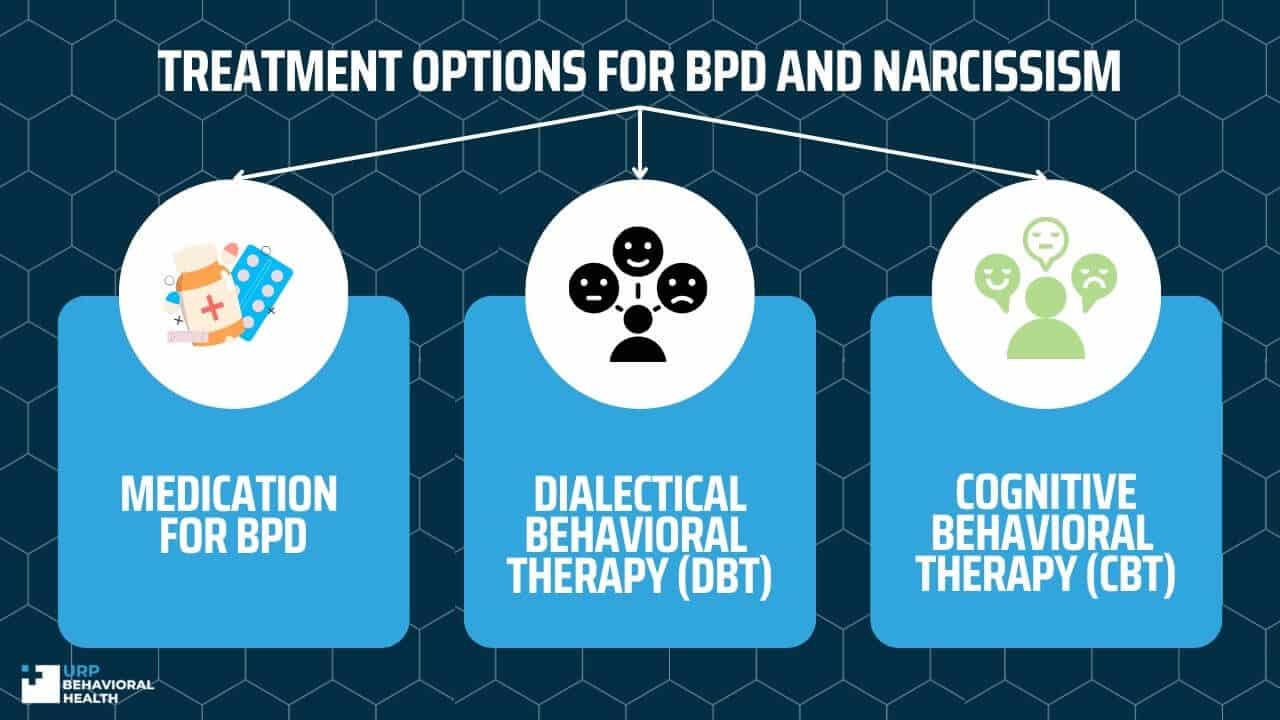
Now that we’ve tackled the issues of treating narcissistic personality disorder let’s talk about the therapy options at hand: BPD-focused treatments. The most effective option includes psychotherapy, during which you’ll work with a clinician to address BPD symptoms.
Medication for BPD
There are currently no medications formulated to treat BPD. However, your healthcare provider may prescribe medication [10] to address isolated symptoms. These include aggressive, depressive, and anxious feelings and behaviors.
Depending on the intensity and frequency of these symptoms, you may have to take antidepressants, antipsychotics, or mood stabilizers as part of your treatment plan. Taking the right medication can alleviate your co-occurring symptoms and stabilize your mental condition. This, in turn, makes you more receptive to therapy.
This shouldn’t come as a surprise. When you’re not burdened with depressive or anxious thoughts, it’s easier to focus on therapeutic interventions.
Dialectical Behavioral Therapy (DBT)
Based on the principles of cognitive behavioral therapy, dialectical behavioral therapy is designed specifically to treat BPD. It’s an evidence-based practice that helps you build four important skills: interpersonal effectiveness, emotional regulation, mindfulness, and distress tolerance.
These skills counter BPD symptoms such as unstable relationships, affective instability, stress-related paranoid ideation, and impulsivity. With consecutive therapy sessions, you’ll learn to cope with strong emotions more effectively without engaging in self-destructive or impulsive behaviors.
Cognitive Behavioral Therapy (CBT)
The most commonly used evidence-based therapy, CBT, is based on the concept that how you behave is dependent on how you perceive the preceding event. Let’s say you think that someone close to you is abandoning you, and it causes you to engage in self-destructive behaviors. According to CBT, these actions are the result of thinking that you’re being abandoned.
But what if you thought that your loved one was just busy at the moment and unable to respond? During CBT, you’ll work with a therapist to engage in cognitive restructuring. This is when you replace unhelpful ideas and beliefs with more realistic ones.
Conclusion
BPD and narcissism are both personality disorders with some overlapping symptoms. Some similarities include a desire for attention and validation from others. There are major differences between the two, such as low self-worth and feelings of superiority in BPD and narcissism, respectively. In some cases, people can develop co-occurring BPD and narcissism, in which case BPD-focused treatments are used and adapted for narcissism. With appropriate diagnosis, therapeutic interventions, and a willingness to recover, you can see a reduction in symptoms.
We’ll help you understand your options and guide you toward care.
References:
- What are Personality Disorders? https://www.psychiatry.org/patients-families/personality-disorders/what-are-personality-disorders
- Personality Disorders – National Institute of Mental Health (NIMH). https://www.nimh.nih.gov/health/statistics/personality-disorders
- Narcissistic Personality Disorder: Diagnostic and Clinical Challenges. https://psychiatryonline.org/doi/10.1176/appi.ajp.2014.14060723
- Clinical Characteristics of Comorbid Narcissistic Personality Disorder in Patients With Borderline Personality Disorder. https://guilfordjournals.com/doi/10.1521/pedi_2017_31_306
- Results from the Wave 2 National Epidemiologic Survey on Alcohol and Related Conditions. https://pmc.ncbi.nlm.nih.gov/articles/PMC2676679/
- Grandiose and Vulnerable Narcissism in Borderline Personality Disorder. https://pubmed.ncbi.nlm.nih.gov/29466803/
- Borderline Personality Disorder with Narcissistic Features. https://link.springer.com/chapter/10.1007/978-3-319-90743-7_13
- Axis II comorbidity of borderline personality disorder: description of 6-year course and prediction to time-to-remission. https://onlinelibrary.wiley.com/doi/10.1111/j.1600-0447.2004.00362.x
- Treatment principles for pathological narcissism and narcissistic personality disorder. https://psycnet.apa.org/doiLanding?doi=10.1037%2Fint0000263
- Current and emerging medications for borderline personality disorder: is pharmacotherapy alone enough? https://www.tandfonline.com/doi/full/10.1080/14656566.2019.1686482



